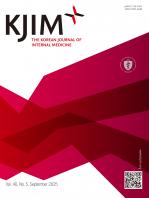|
Gastroenterology / Original Article
Effect of calcineurin inhibitor on post-endoscopic retrograde cholangiopancreatography pancreatitis in patients with liver transplantation: a propensity-matched cohort study
Hyoung-Chul Oh, Jeffrey J. Easler, Ihab I. El Hajj, James Watkins, Evan L. Fogel, Lee McHenry, Stuart Sherman, Hyun Kang, Glen A. Lehman
Korean J Intern Med. 2020;35(6):1364-1370. Published online February 19, 2020
Background/Aims: A calcineurin inhibitor may alter pancreatic function and inflammatory reaction. This study aimed to determine the possible pharmacologic effect of the calcineurin inhibitor, tacrolimus, on pancreatic function, and to determine its preventive effect on post-endoscopic retrograde cho..
|
|
|
Gastroenterology / Original Article
Time-dependent reversal of significant intrapulmonary shunt after liver transplantation
Xin Jin, Byung Joo Sun, Jae-Kwan Song, Jae-Hyung Roh, Jeong Yoon Jang, Dae-Hee Kim, Young-Suk Lim, Jong-Min Song, Duk-Hyun Kang, Sung Gyu Lee
Korean J Intern Med. 2019;34(3):510-518. Published online March 5, 2018
Background/Aims: Although the association between intrapulmonary shunt (IPS) and liver cirrhosis is clear, data of repeated contrast echocardiography (CE) before and after liver transplantation (LT) to evaluate factors associated with IPS are limited.
Methods: Hand-agitated saline was used for CE a..
|
|
|
Gastroenterology / Review
Endoscopic management of anastomotic stricture after living-donor liver transplantation
Dong Wook Lee, Jimin Han
Korean J Intern Med. 2019;34(2):261-268. Published online February 25, 2019
The most effective and fundamental treatment for end-stage liver disease is liver transplantation. Deceased-donor liver transplantation has been performed for many of these cases. However, living-donor liver transplantation (LDLT) has emerged as an alternative because it enables timely procurement o..
|
|
|
Infectious diseases / Original Article
Predictors of postoperative infectious complications in liver transplant recipients: experience of 185 consecutive cases
Seungjin Lim, Eun Jung Kim, Tae Beom Lee, Byung Hyun Choi, Young Mok Park, Kwangho Yang, Je Ho Ryu, Chong Woo Chu, Su Jin Lee
Korean J Intern Med. 2018;33(4):798-806. Published online February 23, 2018
Background/Aims: Infections following liver transplant (LT) remain a major cause of mortality. This study was conducted to evaluate risk factors for infection and to review clinical characteristics.
Methods: Medical records of patients who underwent LT from 2010 to 2014 were retrospectively analyze..
|
|
|
Gastroenterology / Original Article
Outcome of donor biliary complications following living donor liver transplantation
Hyun Young Woo, In Seok Lee, Jae Hyuck Chang, Seung Bae Youn, Si Hyun Bae, Jong Young Choi, Ho Jong Chun, Young Kyoung You, Dong Goo Kim, Seung Kew Yoon
Korean J Intern Med. 2018;33(4):705-715. Published online March 14, 2018
Background/Aims: Biliary complications are the most common donor complication following living donor liver transplantation (LDLT). The aim of this study is to investigate the long-term outcomes of biliary complications in right lobe adult-to-adult LDLT donors, and to evaluate the efficacy of endosco..
|
|
|
Infectious diseases / Original Article
Clinical significance of methicillin-resistant Staphylococcus aureus and vancomycin-resistant enterococci colonization in liver transplant recipients
Youn Jeong Kim, Sang Il Kim, Jong Young Choi, Seung Kyu Yoon, Young-Kyoung You, Dong Goo Kim
Korean J Intern Med. 2015;30(5):694-704. Published online August 27, 2015
Background/Aims: Liver transplant patients are at high risk for methicillin-resistant Staphylococcus aureus (MRSA) and vancomycin-resistant enterococci (VRE) colonization. We evaluated patients before and after liver transplant using active surveillance culture (ASC) to assess the prevalence ..
|
|
|
Original Article
Comparison of the Applicability of Two Prognostic Scoring Systems In Patients with Fulminant Hepatic Failure
Won-Choong Choi, Walid C. Arnaout, Federico G. Villamil, Achilles A. Demetriou, John M. Vierling
Korean J Intern Med. 2007;22(2):93-100. Published online June 30, 2007
BackgroundDistinguishing those patients with fulminant hepatic failure (FHF) and who require transplantation from those FHF patients who will survive with receiving only intensive medical care remains problematic, and this distinction is important because of the chronic shorta..
|
|
|
















